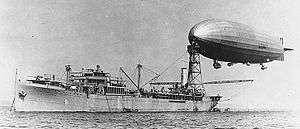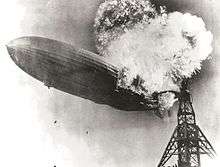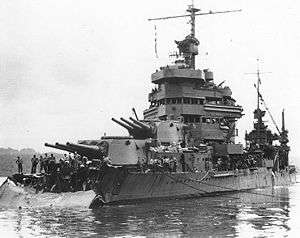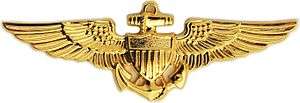Charles E. Rosendahl
| Charles Emery Rosendahl | |
|---|---|
 Lt. Cmdr. Charles Rosendahl, USN, circa 1930 | |
| Nickname(s) | Rosey |
| Born |
May 15, 1892 Chicago, Illinois |
| Died |
May 17, 1977 (aged 85) Naval Hospital Philadelphia, Pennsylvania |
| Allegiance |
|
| Service/branch |
|
| Years of service | 1910–1946 |
| Rank |
|
| Commands held |
Claxton (DD-140) Los Angeles (ZR-3) Akron (ZRS-4) NAS Lakehurst Minneapolis (CA-36) Naval Airship Training Command |
| Battles/wars |
Mexican Revolution World War I World War II |
| Awards |
Navy Cross Distinguished Service Medal Distinguished Flying Cross |
Charles Emery Rosendahl (15 May 1892 – 17 May 1977) was a decorated Vice Admiral in the United States Navy, and an advocate of lighter-than-air flight.
Biography
Early career
Rosendahl was born in Chicago, Illinois. His family subsequently relocated to Kansas and Texas and, in 1910, he was appointed to the Naval Academy from the latter state. Commissioned in the rank of ensign in June 1914, upon graduation from the Academy,[1] he was ordered to join the armored cruiser West Virginia (ACR-5) off Mexico during the Veracruz crisis. After West Virginia was decommissioned he served briefly on the battleship Oregon (BB-3) and the protected cruiser St. Louis (C-20), before reporting for duty aboard the protected cruiser Cleveland (C-19) on 14 May 1915. On 15 September 1916 he returned to the recommissioned West Virginia, which was subsequently renamed the Huntington. On 19 June 1917 he received promotion to lieutenant (j.g), and to full lieutenant on 31 August 1918,[2] having served aboard the Huntington escorting convoys of troops and supplies to Europe during World War I.
From 6 June 1918[2] Rosendahl served as an Engineering Officer, putting the new destroyer McKean (DD-90) into commission.[1] On 30 July 1919 he was ordered to the Pacific Coast for further duty, first serving on the cruiser Brooklyn (CA-3) as Gunnery Officer, and receiving promotion to lieutenant commander on 27 January 1920. In August he began fitting out new destroyers, commissioning, and delivering them to the Fleet; they included the William Jones (DD-308), Yarborough (DD-314), Marcus (DD-321), and Melvin (DD-335). On 11 July 1921 Rosendahl assumed command of the destroyer Claxton (DD-140), before being ordered to duty at the Naval Academy as Instructor in Department of Electrical Engineering and Physics in September.[2]
Move to airships

When the Navy's Bureau of Navigation circulated a letter asking for volunteers for rigid airship duty, Rosendahl volunteered.[2] He reported to Naval Air Station Lakehurst, New Jersey, to be trained in airship operation[1] on 7 April 1923.[2] Designated a Naval Aviator in November 1924, Rosendahl served on the dirigible Shenandoah (ZR-1)[1] as mooring officer and navigator. Promoted to lieutenant commander on 5 January 1925,[2] he distinguished himself by successfully bringing the bow section of the shattered airship safely to earth after she broke up in the air on 3 September 1925 over Noble County, Ohio.[1]
From 9 March 1926 he served as Executive Officer, and then as Commanding Officer from 10 May,[2] of the dirigible Los Angeles (ZR-3),[1] making numerous flights for crew training, radio compass station calibration and flight tests for National Advisory Committee for Aeronautics (NACA). Los Angeles also took part in the searches for Nungesser and Coli's aircraft "The White Bird", and Frances Wilson Grayson's "Dawn", both of which went missing during attempts on trans-Atlantic flights.[2]

In January 1928 Rosendahl flew Los Angeles out to sea off Newport, Rhode Island, to rendezvous with the aircraft carrier Saratoga (CV-3) and moored to the ship's stern to take on fuel and stores. Further experimental flights were undertaken, mooring to the airship tender Patoka (AO-9) during long-range flights.[2]
In July 1928 Rosendahl traveled to Britain to observe their airship activities, and then to Germany for the trials of the airship Graf Zeppelin. In October he was an observer aboard the Graf as she made her first Atlantic crossing from Friedrichshafen to Lakehurst.[2]
On 9 May 1929 he was relieved as Commanding Officer of Los Angeles and assumed duty as the Commander of the Rigid Airship Training and Experimental Squadron at NAS Lakehurst. In August he was aboard the Graf Zeppelin's "Round the World" flight as observer and watch officer.[2] On 27 June 1930[2] Rosendahl was assigned to the Bureau of Aeronautics, in Washington, D.C.,[1] and from 21 October 1931 to 22 June 1932[2] commanded the new dirigible Akron (ZRS-4),[1] during which time experiments in the role as an airborne aircraft carrier were tried. Between July 1932 and June 1934[2] Rosendahl served at sea on board the battleship West Virginia (BB-48) and heavy cruiser Portland (CA-33).[1]

On 11 June 1934 he assumed command at NAS Lakehurst, and was promoted to commander on 1 February 1935. Rosendahl served as an official observer on the German airship Hindenburg, on transatlantic flights between Frankfurt and Rio de Janeiro in August–September 1936. He was in command at Lakehurst on the night of 6 May 1937 and witnessed the destruction of the Hindenburg, leading fire fighting and rescue efforts.[2] He later testified at the Department of Commerce Inquiry into the accident[1] and stated:
| “ | When I saw the first blaze I knew the ship was doomed and I also thought that there would immediately be an explosion which would flatten every building at the field and kill everybody looking on. I thought it was curtains for all of us.[3] | ” |
On 6 August 1938 he was relieved of command of NAS Lakehurst, and on 31 August he reported to Pearl Harbor[2] to serve as Executive Officer of the light cruiser Milwaukee (CL-5).[1]
On 23 May 1940 he was assigned to the office of the Secretary of the Navy for duty in airship evaluations, and was promoted to the rank of captain on 13 July. In September he became the senior member of the Board created to investigate sites for new airship stations. On 25 February 1941 he was detached from that duty to serve in the office of the Assistant Secretary of the Navy, and then on 23 April 1942 to the office of Chief of Naval Operations, under the Director of Fleet Training, for airship training and base selection.[2]
World War II

On 6 September 1942[2] Rosendahl took command of the heavy cruiser Minneapolis (CA-36). The ship was torpedoed during the Battle of Tassafaronga, off Guadalcanal, on 30 November 1942,[1] losing 80 feet (24 m) of her bows and had three of four boilers knocked out. Rosendahl kept her afloat and reached the safety of Tulagi.[2] He was subsequently awarded the Navy Cross.[4] On 15 May he returned to NAS Lakehurst and assumed duty as the Chief of Naval Airship Training Command, receiving promotion to rear admiral on 26 May 1943.[2] This service lasted through World War II,[1] until he retired on 1 November 1946. He was advanced to the rank of vice admiral on the same day.[2]
Post-Navy activities
Between 1947 and 1952 Rosendahl was an aeronautical consultant and a Vice-President of the Flettner Aircraft Corporation, New York. In 1953 he was appointed Executive Director of the National Air Transport Coordinating Committee, a group set up to study air transport problems in the greater New York area after three crashes in Elizabeth, New Jersey, during 1952.[2]
Rosendahl retired to Toms River, New Jersey in 1960 to write and to organize the Lighter-Than-Air Museum Association at Lakehurst. The Navy conditionally deeded land to the LTA Museum Association, but because the group was unsuccessful in raising funds, the land reverted to NAS Lakehurst.[2]
The United States Navy ended airship operations in August 1962. Rosendahl was aboard the N class blimp ZPG-3W on the final flight.[2]
Rosendahl died on 17 May 1977 at the Naval Hospital Philadelphia.[1]
Personal life
On 30 June 1932 he met Jean Wilson on a train en route to Los Angeles, California. They were married on 22 December 1934.[2]
Publications
Rosendahl published several books, as well as numerous scientific and popular articles about airships.
- Up Ship! (1931) Dodd, Mead and Company, New York.
- What About the Airship: The Challenge to the United States (1938) Charles Scribner's Sons, New York.
- A History of U.S. Navy Airships in World War II
- SNAFU: The Strange Story of American Airships
His collected papers are held by the University of Texas at Dallas.[5] These include notes for an unpublished study of the attack on Pearl Harbor written with the assistance of Vice Admiral Ryūnosuke Kusaka, who Rosendahl had first met and befriended on the Graf Zeppelin circumnavigation in 1929.[2]
Memberships
Rosendahl was a member of the following organizations:
- Fellow of the Institute of the Aeronautical Sciences
- Member of Advisory Committee and Trustee of the Clifford B. Harmon Trust
- Past President and Life Honorary Member, Wings Club of New York
- Honorary Member and Past President, John Ericsson Society of New York
- Founder and Member of Army-Navy Country Club, Washington, D.C.
- Fifty-year "Gold Card" member of the American Legion, Past Commander and member of its Air Service, Post 501
- Adventurers' Club
- Ye Ancient and Secret Order of Quiet Birdmen
- International Order of Characters
- Explorers' Club
- The Naval Order of the United States
Honors and awards
Civilian
Rosendahl was the recipient of numerous honors:
- Elder Statesman of Aviation, National Aeronautic Association
- Winner of four Harmon Trophies, Aeronaut-class (1927 & 1940-9), and National Award (1932 & 1933)
- Frank M. Hawks Award
- He was inducted into the Aviation Hall of Fame and Museum of New Jersey in 1980
He also received two honorary degrees:
- Doctor of Science in Aeronautics from the University of Tampa
- Doctor of Laws from Rider College
Military decorations
Here is the ribbon bar of Vice admiral Charles E. Rosendahl:
 | |||
| Naval Aviator Badge | |||||||||||||
| 1st Row | Navy Cross | Navy Distinguished Service Medal | Distinguished Flying Cross | ||||||||||
|---|---|---|---|---|---|---|---|---|---|---|---|---|---|
| 2nd Row | Mexican Service Medal | World War I Victory Medal with Fleet Clasp | American Defense Service Medal with Atlantic Fleet Clasp | ||||||||||
| 3rd Row | Asiatic-Pacific Campaign Medal with one Service star | American Campaign Medal | World War II Victory Medal | ||||||||||
References
- Notes
- 1 2 3 4 5 6 7 8 9 10 11 12 13 14 15 16 17 18 19 20 21 22 23 24 25 26 "Vice Admiral Charles E. Rosendahl Collection" (PDF). utdallas.edu. Retrieved 31 October 2010.
- ↑ "Transport: Waiting Room". TIME. May 24, 1937. Retrieved 1 November 2010.
- ↑ "Military Times Hall of Valor : Awards for Charles Emery Rosendahl". militarytimes.com. Retrieved 1 November 2010.
- ↑ "The Vice Admiral Charles E. Rosendahl Lighter-than-Air Collection". utdallas.edu. Retrieved 1 November 2010.
- Bibliography
-
 This article incorporates public domain material from the Naval History & Heritage Command document permanent dead link] "Vice Admiral Charles E. Rosendahl, USN, (1892-1977)" (retrieved on 31 October 2010).
This article incorporates public domain material from the Naval History & Heritage Command document permanent dead link] "Vice Admiral Charles E. Rosendahl, USN, (1892-1977)" (retrieved on 31 October 2010).
Further reading
- Althoff, William F., Sky Ships: A History of the Airship in the United States Navy, (July 1998) Pacifica Press, California. ISBN 978-0-935553-32-1
- Shock, James R., U.S. Navy Airships 1915-1962: A History by Individual Airship. (2001) Atlantis Productions. ISBN 0-9639743-8-6